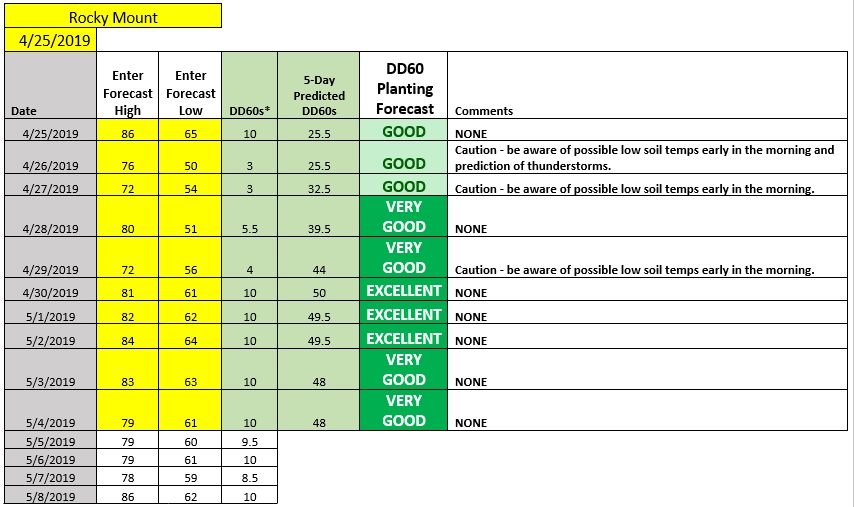Cotton Planting Conditions April 25, 2019
go.ncsu.edu/readext?599099
en Español / em Português
El inglés es el idioma de control de esta página. En la medida en que haya algún conflicto entre la traducción al inglés y la traducción, el inglés prevalece.
Al hacer clic en el enlace de traducción se activa un servicio de traducción gratuito para convertir la página al español. Al igual que con cualquier traducción por Internet, la conversión no es sensible al contexto y puede que no traduzca el texto en su significado original. NC State Extension no garantiza la exactitud del texto traducido. Por favor, tenga en cuenta que algunas aplicaciones y/o servicios pueden no funcionar como se espera cuando se traducen.
Português
Inglês é o idioma de controle desta página. Na medida que haja algum conflito entre o texto original em Inglês e a tradução, o Inglês prevalece.
Ao clicar no link de tradução, um serviço gratuito de tradução será ativado para converter a página para o Português. Como em qualquer tradução pela internet, a conversão não é sensivel ao contexto e pode não ocorrer a tradução para o significado orginal. O serviço de Extensão da Carolina do Norte (NC State Extension) não garante a exatidão do texto traduzido. Por favor, observe que algumas funções ou serviços podem não funcionar como esperado após a tradução.
English
English is the controlling language of this page. To the extent there is any conflict between the English text and the translation, English controls.
Clicking on the translation link activates a free translation service to convert the page to Spanish. As with any Internet translation, the conversion is not context-sensitive and may not translate the text to its original meaning. NC State Extension does not guarantee the accuracy of the translated text. Please note that some applications and/or services may not function as expected when translated.
Collapse ▲Keith Edmisten, Professor of Crop Science & Soil Sciences and Extension Cotton Specialist
Guy Collins, Extension Associate Professor – Cotton
Soil temperature at a 3-inch depth was 64.4 degrees at 8 this morning (April 24). Soil temperature quickly increased to almost 76 degrees by 4:00 p.m. The DD60’s predicted for the 5 days following planting at Rocky Mount are included in the table below. Conditions look pretty good at this point but can certainly change quickly as these predictions are based on a 10-day weather forecast. Note that planting on April 26 triggered a warning based on low temperature. Based on soil temperatures the past few days, growers should be able to plant that day, but they may want to check soil temperatures in the morning. Planting a larger seeded variety with high cool germ would certainly help. What is more alarming concerning planting today (April 25) or the following day, is that there is a 100% prediction of thunderstorms on the 26. This is especially concerning for those planting on soil that tend to crust. The 10-day prediction is for very little rain from April 27 through May 3.
The table below is for Rocky Mount and based on the 10-day forecast. As spring weather forecasts can often differ across the state, we strongly encourage you to get a more local forecast that can be easily updated daily using the new NC State University Cotton Planting Conditions Calculator. The calculator can be found on the Cotton website under the link “Calculators and Decision Aids” on the left-side toolbar, or directly on the Cotton Planting Conditions Calculator website. We encourage growers to use and monitor the calculator twice daily to account for potential changes in weather forecasts for your region or farm. Simply click on your farm location on the map, and click “submit” for your local planting conditions forecast.
It is certainly possible to achieve a good stand-in marginal conditions. Please consult Strategies for Planting Cotton in Suboptimal Conditions if you decide to plant under marginal conditions.
The chart below illustrates how we define planting conditions. We cap DD60’s at a maximum value of 10 for each day. If you are computing DD60 accumulation on your own and a day is predicted to have 15 DD60’s, only use 10 for that day. We also lower the planting conditions by one category if a low of 50 or less or DD60=0 is predicted on the day of planting.
| Relationship Between Predicted DD-60s and Planting Conditions. | |
| Predicted DD-60 accumulation for five days following planting |
Planting conditions
|
| 10 or fewer | Very poor |
| 11 to 15 | Marginal |
| 16 to 25 | Adequate |
| 26 to 35 | Good |
| 36-45 | Very good |
| 46 or greater | Excellent |
| Avoid planting cotton if the low temperature is predicted to be below 50°F for either of the two nights following planting or predicted daily DD60’s is near zero for the day of planting. | |



